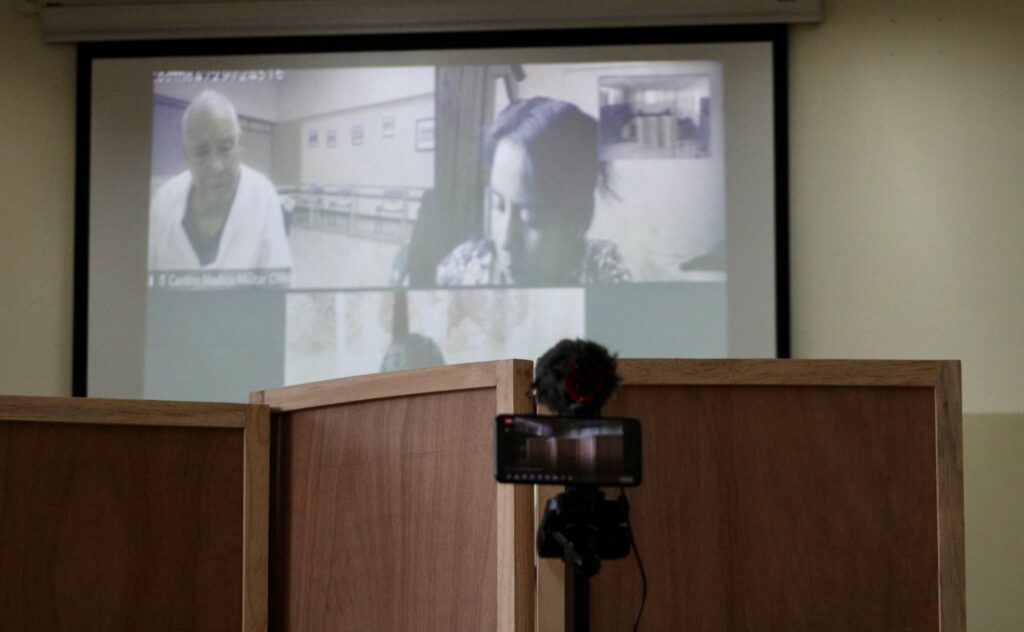
Photo by NISGUA. Defense witnesses testify in the Ixil Genocide Trial. Tuesday, July 16.
Weekly Update for July 15-18
Monday, July 15, hearing 47
On Monday the 15th, the lawyers of Manuel Benedicto Lucas García presented 2 witnesses on behalf of the defendant. At the request of the defense, screens were placed in the courtroom to protect the identity of the witnesses and a psychologist was present.
The first witness indicated that several of her family members were victims of the Internal Armed Conflict (IAC) and said that guerrilla elements came to her community and asked them for food, but her mother said that they could not feed them. Because of this the guerrilla elements forced them to leave their home and all their belongings, so they had to go to live in Chajul. When questioned by the Public Prosecutor, she indicated that she had a total of 3 biological children and that she adopted a 4th one.
She stated that on one occasion a second lieutenant known as “Camilo” and a colonel wearing red berets (which identifies the Kaibiles), took about 50 children to the town of Chajul because they had killed their parents in Aldea Chel, Aldea Cabá and Chemal in the municipality of Chajul, Quiché and the officers offered the children to the people. She explained that the army gave her this girl for “adoption” because they told her that her mother had died in the mountains. She indicated to the lawyer of AJR that they did not pay for the children, they only picked them up, and that she did not see if those who were not adopted were transferred by helicopter to another region.
According to ODHAG, “this would confirm the appropriation or theft of children, as well as the ‘illegal adoptions’ committed by members of the Guatemalan Army during the war”.
The second witness indicated that she was originally from Chajul, Quiché and that her mother died when she was 7 years old and that her father was killed by the guerrillas in April, but she did not remember the year or who the president was at the time. She said that it was because of the intervention of the soldiers that she survived the IAC.
She said she does not remember what the guerrillas told the villagers to convince them to join them. She only remembers that she was told that they [the guerrillas] were killing people. She testified that she heard that wounded soldiers were returning to the municipality, but that she did not see them. She indicated that no one threatened her to come testify.
According to the ODHAG, the testimonies of two other witnesses presented by the defendant do not correspond with the facts that are being judged in time, manner and place.
Tuesday, July 16, hearing 48
On Tuesday, April 16, the first witness to appear, a woman from Chajul, related that her father, who had been mayor of the community, was murdered by members of the guerrillas on April 11, 1981. She indicated that on the day of the events, 30 guerrilla members, including men and women, came to her community demanding food. However, her father refused to give them his grain and animals. For this reason they shot him in the stomach. Like one of the witnesses who testified yesterday, she reported that the army collected children, saying that the guerrillas had killed their parents, and then handed them over to the villagers saying: “whoever does not have children can take one”. She asked for justice for her father.
According to the ODHAG: “For the second consecutive day, a witness proposed by the Accused of Genocide, General (r) Benedicto Lucas García, testified before the Tribunal that is carrying out the Trial how the Guatemalan Army appropriated and gave away children who survived the massacres: “…I saw how the army took children and said that the guerrillas had killed their parents. They gave them away to the people [without a legal adoption process]… the children were very thin, you could see that they had no peace, they didn’t even have a smile, they were dying.”
Diego Cobo de León, originally from Aldea Cotzol, Santa María Nebaj, was the second witness of the day proposed by Benedicto Lucas García. He related that his grandparents had died for not collaborating with the guerrillas and that this had happened between 1980 and 1981. He explained that he joined the Guerrilla Army of the Poor out of fear, received a 3-month course, and then worked with them training people for 6 more months. After 9 months, he said, “I got bored and came to the town [Santa María Nebaj] in 1983. He said that when he arrived in Santa María Nebaj he gave the army the names of some of the guerrilla high commanders and they gave him the opportunity to be part of the PAC. He was PAC for 10 years.
He confirmed to the Tribunal that “…The army cut the corn that the people planted in the mountains […] many people died of hunger, thirst, disease, they had no clothes, the poor women walked around with torn and patched clothes […] they didn’t even have blood anymore, the people were lost [and] when the army saw smoke in the mountains they threw bombs, they bombed every time they saw that someone was making a fire”.
The third witness recounted an event that happened when he lived in the village Parramos in which 15 guerrilla members took his 3 brothers, on April 15, 1982. He moved to Santa María Nebaj, and already in Nebaj he cut the soldiers’ hair. “They told me that I had to cut their hair, that you are not going to patrol, they told me.” He replied to questioning that he was not paid, it was free of charge.
Wednesday, July 17, hearing 49
A 52-year-old defense witness from Santa María Nebaj was presented. She said that on April 3, 1982, the guerrillas entered her house, stole her belongings, and abused her. In June of the same year she said that the guerrillas kidnapped her father, another family member and two other people. According to Verdad y Justicia, the witness said that her father had been a businessman, catechist, PAC, and contractor for the La Perla Ranch (he recruited people for the ranch).
She testified that there were 500 guerrillas in her community, who wore olive-colored uniforms, rubber boots, and carried long guns. Like all the defense witnesses, she said that the Guatemalan army helped them survive the guerrilla attacks.
She responded to questioning by the Public Prosecutor that she was not a witness to the events that her father and brother were victims of, but that she knew about them because someone told her about them. Most of the facts that the defense witnesses recounted this week are outside the period of the crimes Manuel Benedicto Lucas García is accused of.
Thursday, July 18, hearing 50
On this day, the audios of the advance statements recorded on CD of the witnesses Diego López, Petrona Raymundo and María Marcos were played. In his statement, Mr. Diego López Cruz told how on January 12, 1982, members of the army kidnapped and then murdered his father and two other people. He indicated that, 10 days after burying his father, elements of the army returned to the community, but this time they took his mother. He said that on February 23 of that same year the army killed his brothers. He stated that to save his life and that of his family he moved to the coast and that while he was there 2 neighbors from his community arrived (also displaced) to tell him that the army had burned all the houses in the town. He explained that he lived for 14 months on the coast.
In her testimony, Mrs. Petrona Raymundo narrated that on March 25, 1982, members of the army arrived in her community at 6:00 a.m. and forced all the villagers to leave their homes. She explained that they took them to the center of town where the women were locked in a house and the men were tied up in the town square. She said that 5 soldiers took her daughter, Magdalena Brito Raymundo (10 years old) and 2 other girls and took them to another room and abused them. She responded that it was her daughter who told her about the abuse she was a victim of. She added that the soldiers were dressed in camouflage, with long guns and leather boots. She stated that she did not know where the soldiers had come from that day. She added that they left around 3pm and that both women and men were released.
Witness María Marcos said that in January 1981, members of the army came to her community and killed three of her children and that she was beaten and wounded in the neck with a knife. She added that they also burned her crops, killed her animals, burned her houses and killed other people. It is worth mentioning that the facts related in the last two testimonies do not fall within the time frame of the crimes Manuel Benedicto Lucas García is accused of.

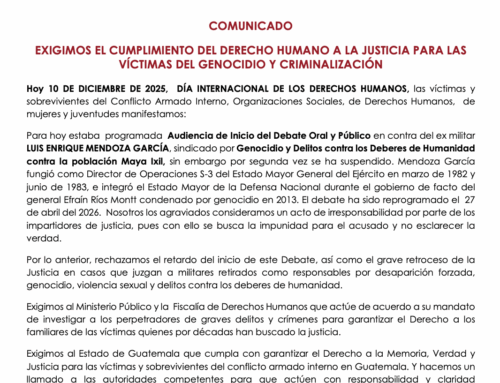
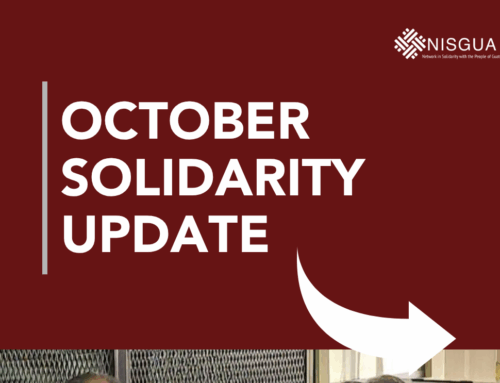
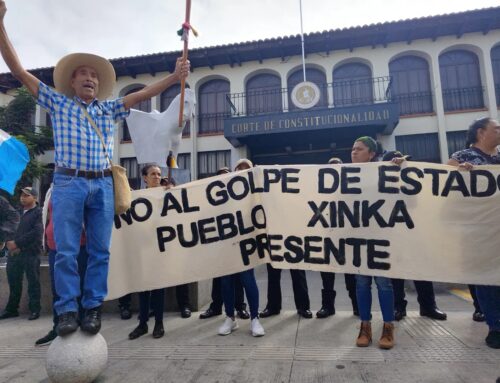
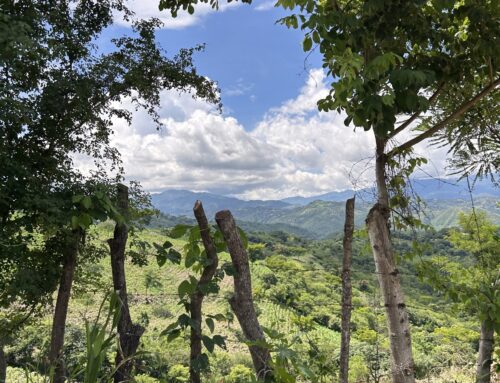
Leave A Comment